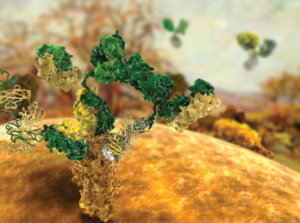
Antibody response.
Ramón Andrade, 3Dciencia/Science Source
Researchers say a study of individual antibody response to citrullinated and non-citrullinated proteins in sputum samples further supports the importance of the lung in early development of rheumatoid arthritis-related autoimmunity.
Investigation of the fundamental mechanism that leads to antibody responses in rheumatoid arthritis is key to uncovering ways to predict and prevent the development of rheumatoid arthritis, note authors of the study in the journal Arthritis & Rheumatology. They say their study adds to growing evidence suggesting lung mucosa is a major site of antibody generation related to the disease.
“These are early findings that could identify potential sputum biomarkers that could help with predicting rheumatoid arthritis,” says lead author Kristen Demoruelle, MD, a rheumatologist and assistant professor of medicine at the University of Colorado, School of Medicine, Division of Rheumatology, Denver.
The Study

Dr. Demoruelle
Specifically, researchers explored antibody responses to citrullinated and non-citrullinated proteins and their associations with the presence of neutrophil extracellular traps (NETs)—a unique form of cell death called netosis—in the sputum of subjects at risk for the development of rheumatoid arthritis. Antibodies to citrullinated protein/peptide antigens occur primarily in patients with rheumatoid arthritis and are instrumental in diagnosis of the disease.
“The goal of the study is to try to understand more about the origins of autoimmunity and rheumatoid arthritis,” says Dr. Demoruelle. “We focus on looking at the lung mucosa site where ACPAs [anti-citrullinated protein antibodies] may originate prior to the onset of joint disease. …
“This study, in particular, was trying to look at individual ACPA reactivities to see if we could identify early antigenic targets in the development of autoimmunity in rheumatoid arthritis,” she says. “If we can identify some of these early antigen targets or some of the antigens associated with the progression toward joint disease, those are potential targets for preventive interventions.”
Included in the study were 41 subjects considered at risk for developing rheumatoid arthritis based on familial or serologic risk factors, 20 subjects with classified rheumatoid arthritis and 22 healthy subjects who served as a control. Researchers analyzed serum and sputum samples from all subjects using a bead-based array for IgG reactivity to 29 citrullinated proteins and 21 non-citrullinated proteins; cutoff levels for antibody positivity were established in a separate control group.
The Results
Among at-risk subjects, researchers found a high prevalence of antibody responses to the citrullinated forms of fibrinogen, apolipoprotein E and fibronectin, proteins that could turn out to be the earliest antigen targets of antibodies generated in the lung, states the article. These results might one day be useful to medically screen people who are either at risk for rheumatoid arthritis or in the very early stages of developing it, says Dr. Demoruelle.
The most citrulline-specific antibodies found in the sputum of the at-risk group were fibrinogen, vimentin and peptides of fibrinogen A and apolipoprotein A1, according to the article. Also found in the serum of test subjects, these proteins could be involved in transition of the disease from mucosal to systemic autoimmunity, says Dr. Demoruelle.
“This could be a protein target that starts in the lung and then transitions to the blood and then maybe has a joint target over time,” she says.
Results also showed a difference in patterns of sputum autoantibody positivity in at-risk subjects compared with those with rheumatoid arthritis. This suggests that there may be a progression of immune response known as epitope spreading in the lung prior to onset of the joint disease; however, longitudinal studies are needed to further explore that possibility and other results from the study, says Dr. Demoruelle.
“It’s been shown in the blood that during the preclinical period, individuals have epitope spreading where they develop increased ACPA reactivities prior to the onset of joint disease,” says Dr. Demoruelle. However, this is the first study to suggest it may also be happening in the lung, she says.
“If epitope spreading is also occurring in the lung during the preclinical period, it could be that the lung is helping shape some of these antibody responses,” says Dr. Demoruelle, “… where an initial response to only a few proteins or peptides blossoms into a larger immune response to multiple different citrullinated protein.”
Additional findings demonstrated a strong correlation between increasing sputum NET levels and several citrullinated and some non-citrullinated antibody reactivities in those subjects from the at-risk study population. That could mean that sputum antibodies target NETs or the other way around, says Dr. Demoruelle.
“There seems to be a connection between them, … but additional studies are needed to understand the chicken or the egg in this process,” says Dr. Demoruelle. “The finding that sputum antibodies correlated with non-citrullinated proteins is also of interest. Certainly, NETs also have non-citrullinated proteins and could be triggering antibody responses in a similar fashion.
“It’s also possible that it’s a marker of general inflammation and that’s why we are seeing the correlation, but we think that’s less likely because we didn’t see the NET levels correlating with other antibodies, [such as] the rheumatoid factor.”
The study identified ‘several sputum autoantibodies of particular interest in subjects at risk for the future development of RA, including sputum ACPAs with early citrulline specificity & those with strong associations with NETs in the sputum.’
The study identified “several sputum autoantibodies of particular interest in subjects at risk for the future development of RA, including sputum ACPAs with early citrulline specificity and those with strong associations with NETs in the sputum,” conclude the authors. “These findings further support the hypothesis that the lung likely plays an important role in the development and evolution of RA-related autoimmunity,” states the article.
Dr. Demoruelle points out that among the people in the study considered at risk, some will go on to develop rheumatoid arthritis, but others will not. Future studies are planned to follow both groups to further explore the earliest features of antibody generation in the lung mucosa, she says.
“We understand that in this cross-sectional study, we can’t say that these antibody responses are all going to progress to RA,” she says. “Following them forward, even if someone’s antibody resolves over time, could be really important to understanding the bigger picture of how rheumatoid arthritis develops.”
Dr. Demoruelle notes that the ACPA test—in use for many years—was developed on the basis of citrullinated protein relevance in the joint tissue.
“Certainly, going forward, we are also interested to understand if there are unique antibody responses to citrullinated proteins in the lung that need to be identified and could be different from those that we’ve looked at, …” which have been associated with RA-related joint disease.
Catherine Kolonko is a medical writer based in Oregon.
Reference
- Demoruelle MK, Bowers E, Lahey LJ, et al. Antibody responses to citrullinated and noncitrullinated antigens in the sputum of subjects with rheumatoid arthritis and subjects at risk for development of rheumatoid arthritis. Arthritis Rheumatol. 2018 Apr;70(4):516–527.
